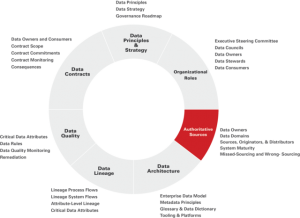Establishing an authoritative sources capability confirms the enterprise approved source for data ownership, including both origination and distribution. Before a financial institution can agree on authorized sources of data, there must first be a common understanding of the type of data being sourced.
Data will need to be classified in an agreed-upon enterprise data model. This model will define the data class, which along with the business line, product, and any other required dimensions, constitute a data domain.
The data domains will serve as differentiators that will allow the creation of a catalog of data sources, originators, and distributors. Each data council is responsible for confirming the authoritative sources of the data under their ownership.
The maturity of each confirmed authoritative source should also be measured against requirements for data privacy, security, ownership and system reliability. Sources that are not compliant with these standards need to be upgraded or replaced.
Other areas where authoritative sources initiatives can add value include assisting the data councils to identify instances of missed sourcing and wrong sourcing. Missed sourcing is the identification of data classes under data council ownership for which an authoritative source has not yet been identified.
Wrong sourcing involves reviewing consumers to identify instances where non-authoritative sources or unnecessary distributors are being used and manipulated data may be being distributed or used as if it came from an authoritative source.
We recently published a guide that explores the building blocks (i.e., data governance components) of data governance, which can help drive better business decisions, enhance regulatory compliance, and improve risk management. You can download it here.


